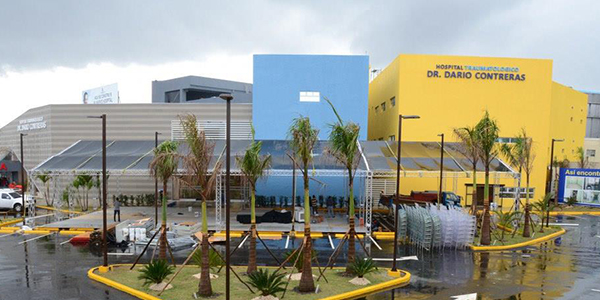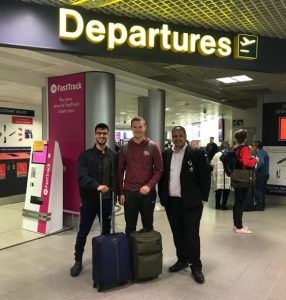
May 23, 2019, by Kelly Calladine
Medical placements in the Dominican Republic
Abidul Ahad, Curtis Brownrigg, and Ahmed Khan received Cascade funding to undertake medical placements in the Dominican Republic in the second year of their Medical Physiology and Therapeutics BSc course. Below is an extract from their report on their two-week experience.
On the 17th June 2018, we flew out to Santo Domingo, Dominican Republic to undertake a two-week hospital placement in a local public hospital. The placement was organised by a reputable company called Gap Medics, whose main aim is to provide work experience for 16 to 25-year-old individuals, aspiring for a career in healthcare. Whilst on placement we stayed at the Gap Medics house with other like-minded students, a 30-minute bus journey from the hospital.
Our work experience took place in “Hospital Docente Universitario Dr. Dario”, a public hospital in the centre of Santo Domingo. It is the biggest trauma hospital in the Dominican Republic. The hospital currently has 211 beds and 418 doctors (402 specialized doctors) and 137 resident doctors. This hospital provides free healthcare to patients, however, costs of additional materials that are needed in surgery must be covered by private medical insurance or the patient, directly.
There are six specialties within the hospital: Emergency Medicine, Trauma and Orthopaedics (T & O), Anaesthesiology, Neurosurgery, Paediatric Trauma and Maxillofacial surgery. We were allocated departments prior to our arrival, between us we shadowed doctors in paediatrics, emergency medicine and T & O. We also completed a night shift in the emergency department to observe how the demands of the hospital altered after elective surgeries had ended.
Arrival

Ahmed, Curtis, and Abidul (left to right) at Manchester Airport, departing for the first of three flights.
After 26 hours of travelling we finally touched down at Santo Domingo airport, where we were welcomed by a blast of humid air, a climate we knew we’d have to get accustomed to. It was the only time for the whole two weeks we were there that we were grateful of the humid atmosphere. We collected our bags and headed for the exit where we were greeted by a member of the Gap Medics staff and the rest of the students who had arrived that evening.
We had a 30-minute journey back to the Gap Medics house, our first experience of the racing driver mentality that seemed to exist in the Dominican Republic. It wasn’t apparent at this point, but road traffic collisions were responsible for most of the patient’s injuries that we saw whilst on placement. We arrived at the house at 00:30 and were shown to our rooms. After a brief tour and being told that breakfast was at 6:00am, we decided it was time to get some sleep (5 hours – the maximum amount of sleep that a Doctor in the Dominican Republic gets per night).
Experiences
Prior to our arrival in the Dominican Republic we were each allocated two departments, one for each week of the placement. Within that department we were assigned a mentor, who was a doctor currently practicing within the hospital. Every day, we shadowed our respective doctors, whether they were in the operating theatres or visiting patients on ward rounds, we were there to observe what they were doing. All the doctors worked in teams, allowing us to interact with the various other healthcare professionals as well as our mentor.
Although the language barrier did prove challenging at some points, our mentors all spoke English and were able to help with translating the Spanish spoken by patients and staff.
We had two Global Health Tutorials in the Dominican Republic by our medical mentor, Dr. Alicia Parsons. The first session was about abortion and Moebius syndrome in the Dominican Republic. The second session was about the healthcare system in the Dominican Republic and how religion and culture affect the healthcare system.
Orphanage volunteering
During our two weeks in the Dominican Republic we were lucky enough to volunteer twice at a local orphanage, called ‘Ama a tu Projimo’, which homed around 20 children, with four carers. The Santo Domingo Gap Medics team bring the placement students to the orphanage every week, providing a continuous social support for the orphanage.
Before going to the orphanage, we went to a supermarket to purchase donations for the children, e.g. toys, books, food. After this we went straight to the orphanage. Upon arrival, we put the food items in the kitchen. We put the toys on the dining tables for the children to pick what they want. Some the kids were watching TV when we arrived. Others were in their rooms, not doing much.
We had an introduction to the orphanage and children. The orphanage was a quaint two-story house with 4 bedrooms, a dining area, kitchen, living room, prayer room and a terrace for outdoor play. The children were aged between 5-16 years old. The children were staring at us with curiosity and some apparent nervousness.
The volunteers all separated out with a specific child or set of children, where they then enjoyed activities together – i.e. colouring, football, and even paper airplanes. Body language was the main way of communicating as there was a language barrier – the main language in the Dominican Republic is Spanish. We had to quickly adapt to communicating without speech, which was pivotal for integrating within this different culture.
On the first week, Abidul and Curtis enjoyed the company of a group of 3 children. They started off with colouring with them and then ended up playing on our phones. This peaked their interest as this technology is not common to them. Furthermore, Curtis showed them videos of a kitten, Sonny, which the children really loved. During this time, Hamza was playing football with several children and other volunteers in the outdoor terrace. The older children really enjoyed this. The children were really friendly and building a rapport was really easy. On the second week, Abidul coloured with a few children and other volunteers. Curtis and Hamza played football with some children and volunteers in the outdoor terrace.
Visiting this orphanage was an emotional experience, which was life-changing to say the least. Of course, it made us all more appreciative of what we had back home.
Abidul, Curtis and Ahmed are planning to study graduate entry medicine.
No comments yet, fill out a comment to be the first

Leave a Reply